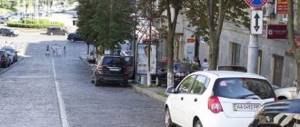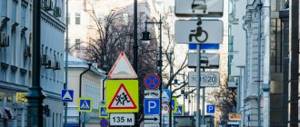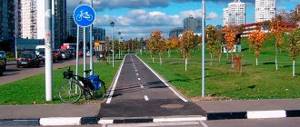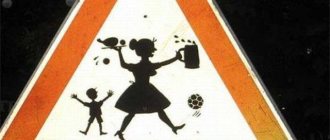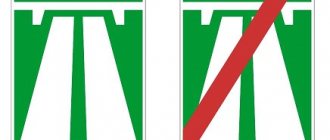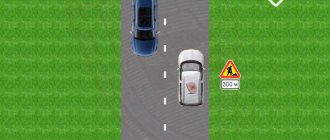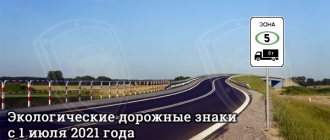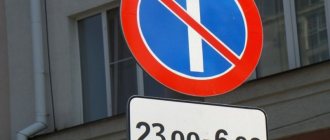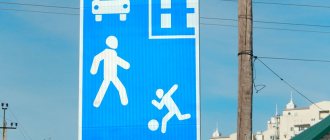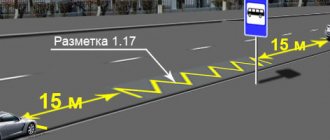Sign 3.13 “Height limitation”
Road sign 3.13 “Height limit” is used to prohibit the movement of vehicles whose overall height (laden or unladen) is greater than that indicated on the sign.
The sign is installed in cases where the distance from the road surface to the bottom of the span of an artificial structure, utilities, gates, etc. (span height) less than 5 meters.
The height indicated on the sign is 0.2 - 0.4 meters less than the actual height. These are the norms. Moreover, this difference between the actual height and the height indicated on the sign can be increased depending on the evenness of the road surface (the number on the sign is slightly less than the actual span height).
If the height of the vehicle (with or without a load) is greater than indicated on the sign, then the driver must drive around the road section along a different route. To warn the driver about the vehicle height restriction ahead, sign 3.13 is duplicated, i.e. are also pre-installed.
Preliminary sign 3.13 “Height limit” with plate 8.1.1 “Distance to object” is installed behind the intersection at the beginning of the road section on which vehicle height restrictions are introduced. Accordingly, at this intersection it is possible to choose a different route.
Repeated sign 3.13 (main) is installed directly at the place of restriction. It is allowed to install a sign on the span of an artificial structure, and if there is a large gate in front of it, on the gate.
The yellow background of sign 3.13 “Height limitation” means that the sign is temporary.
Requirements of road sign 3.13
The “Height Limit” road sign establishes a prohibition for vehicles whose height does not comply with the parameters indicated on the sign. Not only the design of the vehicle must be taken into account, but also the possibility of its operation with a load.
The establishment of this ban involves ensuring the safety of road structures that are encountered on the path of heavy trucks.
These include:
- overpasses;
- bridges;
- crossings for citizens above the road;
- iron structures above the road on which outdoor advertising is mounted;
- video surveillance system;
- as well as structures with road lighting.
By observing the requirements of sign 3.13, the driver will avoid administrative liability for violating the requirements of road signs and civil liability for causing damage to the property of the owner of roads or installed structures above the roads.
Penalty for violating sign 3.13 “Height limit”
For failure to comply with the requirements of sign 3.13 “Height Limitation,” sanctions may be imposed on the driver in the form of a warning or a fine of 500 rubles under Part 1 of Article 12.16 of the Administrative Code.
If an attempt to pass under the “Height Restriction” sign resulted in undesirable consequences for the span, cargo or vehicle in the form of damage, i.e. caused an accident, then the sanctions will be different.
Responsibility for the driver for violating the permissible dimensions of the vehicle when transporting cargo is determined by parts 1-6 of Article 12.21.1 of the Administrative Code. The “range” of fines varies from the degree of violation of the rules for transporting goods from 1 to 10 thousand rubles per driver, with the detention of the vehicle.
Rules for installing a sign 3.13
Installation of sign 3.13 “Height limitation” is carried out before the start of the prohibited zone, which has a height restriction for vehicles, for example, 3.5 meters. The height is taken into account by calculating the distance from the road surface to the lower edge of the utility structure, for example, a bridge.
In accordance with GOST, a small margin is provided in the values of the sign and engineering communications. So, for bridges, overpasses, tunnels, a road sign can set a height less than 20-40 centimeters from the current one, and for overpasses 30-40 centimeters less than the possible height. This reserve is allocated in case of laying a new road surface under engineering road structures.
Duplication of sign 3.13 is carried out in combination with vertical markings 2.1.1-2.1.3, 2.2, which are applied directly on the upper or side edges of the engineering structure.
The applied paint has reflective properties, which is effective at night. Accordingly, the driver who sees the height requirements of the sign must follow the sign in the direction of a detour outside the restricted area. There will be a sign indicating the detour direction next to sign 3.13.
If signs are installed on a yellow background, it will mean that they are in effect temporarily. If contradictions between stationary and temporary signs are detected, you should be guided by the information of the latter.
Sign 3.14 “Width limitation”
Road sign 3.14 “Width limitation” is used to prohibit the movement of vehicles whose overall width (laden or unladen) is greater than that indicated on the sign.
The sign is installed in front of the passage if its width is less than 3.5 meters (for example, in a tunnel, between bridge supports and in other narrow places). The width indicated on the sign is 0.2 meters less than the actual width. These are the rules.
If the width of the car (with or without a load) is greater than on the sign, then the driver must go around this section of the road along a different route. To warn the driver about the existing vehicle width restriction ahead, sign 3.14 is installed twice, i.e. there will be a preliminary sign first.
Preliminary sign 3.14 “Width limitation” with plate 8.1.1 “Distance to object” is installed behind the intersection at the beginning of the road section on which vehicle width restrictions are introduced. At this intersection, the driver can change his route and choose a different direction.
Repeated sign 3.14 (main) is installed directly at the place of restriction. It is allowed to install a sign on a span or support of an artificial structure.
The yellow background of sign 3.14 “Width limitation” means that the sign is temporary.
Prohibiting road signs 3.13-3.16
Last update: 09.25.2019 No comments
- Prohibition road signs
- Prohibition sign 3.1 “Entry prohibited”
- Prohibiting road signs 3.2-3.4
- Prohibiting road signs 3.5-3.10
- Prohibition signs 3.11-3.12 “Weight limit”
- Prohibiting road signs 3.13-3.16
- Prohibiting road signs 3.17.1-3.17.3
- Prohibiting road signs 3.18.1, 3.18.2, 3.19
- Prohibiting road signs 3.20-3.23
- Prohibitory road signs 3.24-3.26
- Prohibitory road signs 3.27-3.30
- Prohibiting road signs 3.31-3.33
Prohibiting road signs limiting traffic according to vehicle dimensions: “Height limitation”, “Width limitation”, “Length limitation” and the “Minimum distance limitation” sign. What are they used for, where and how are they installed. What do the numbers on these signs mean and the penalties for violating the requirements of these signs.
Sign 3.13 “Height limitation”
Road sign 3.13 “Height limit” is used to prohibit the movement of vehicles whose overall height (laden or unladen) is greater than that indicated on the sign.
The sign is installed in cases where the distance from the road surface to the bottom of the span of an artificial structure, utilities, gates, etc. (span height) less than 5 meters.
The height indicated on the sign is 0.2 - 0.4 meters less than the actual height. These are the norms. Moreover, this difference between the actual height and the height indicated on the sign can be increased depending on the evenness of the road surface (the number on the sign is slightly less than the actual span height).
If the height of the vehicle (with or without a load) is greater than indicated on the sign, then the driver must drive around the road section along a different route. To warn the driver about the vehicle height restriction ahead, sign 3.13 is duplicated, i.e. are also pre-installed.
Preliminary sign 3.13 “Height limit” with plate 8.1.1 “Distance to object” is installed behind the intersection at the beginning of the road section on which vehicle height restrictions are introduced. Accordingly, at this intersection it is possible to choose a different route.
Repeated sign 3.13 (main) is installed directly at the place of restriction. It is allowed to install a sign on the span of an artificial structure, and if there is a large gate in front of it, on the gate.
The yellow background of sign 3.13 “Height limitation” means that the sign is temporary.
Penalty for violating sign 3.13 “Height limit”
For failure to comply with the requirements of sign 3.13 “Height Limitation,” sanctions may be imposed on the driver in the form of a warning or a fine of 500 rubles under Part 1 of Article 12.16 of the Administrative Code.
If an attempt to pass under the “Height Restriction” sign resulted in undesirable consequences for the span, cargo or vehicle in the form of damage, i.e. caused an accident, then the sanctions will be different.
Responsibility for the driver for violating the permissible dimensions of the vehicle when transporting cargo is determined by parts 1-6 of Article 12.21.1 of the Administrative Code. The “range” of fines varies from the degree of violation of the rules for transporting goods from 1 to 10 thousand rubles per driver, with the detention of the vehicle.
Sign 3.14 “Width limitation”
Road sign 3.14 “Width limitation” is used to prohibit the movement of vehicles whose overall width (laden or unladen) is greater than that indicated on the sign.
The sign is installed in front of the passage if its width is less than 3.5 meters (for example, in a tunnel, between bridge supports and in other narrow places). The width indicated on the sign is 0.2 meters less than the actual width. These are the rules.
If the width of the car (with or without a load) is greater than on the sign, then the driver must go around this section of the road along a different route. To warn the driver about the existing vehicle width restriction ahead, sign 3.14 is installed twice, i.e. there will be a preliminary sign first.
Penalty for violating sign 3.14 “Width limitation”
For failure to comply with the requirements of sign 3.14 “Width Limitation,” sanctions may be imposed on the driver in the form of a warning or a fine of 500 rubles under Part 1 of Article 12.16 of the Administrative Code.
If an attempt to drive under the “Width Restriction” sign resulted in undesirable consequences for the structure of the span, cargo or vehicle in the form of damage, in other words, became the cause of an accident, then the sanctions will be different, based on the results of the investigation.
Responsibility for the driver for violating the permissible dimensions of the vehicle when transporting cargo is determined by parts 1-6 of Article 12.21.1 of the Administrative Code. The “range” of fines varies from the degree of violation of the rules for transporting goods from 1 to 10 thousand rubles per driver, with the detention of the vehicle.
Liability for violation of sign 3.13
Failure by the driver of a heavy truck to comply with the requirements of road sign 3.13 may result in administrative liability under Part 1 of Article 12.16 of the Code of Administrative Offenses of the Russian Federation in the form of a possible warning or a 500 ruble fine.
If the driver is stopped by traffic police officers to check the permissible dimensions, then if the permissible parameters, which are calculated in centimeters from 10 to over 50, are exceeded, the truck driver will be subject to penalties under the relevant part of Article 12.21.1 of the Administrative Code.
Also, following common sense, you can understand that overcoming an unacceptable height can lead to adverse consequences for the cargo and the vehicle as a whole.
There are currently height restrictions on roads across the country. According to GOST, when using road devices, in particular those of a cargo nature, the dimensions through which safe movement on highways is carried out must be taken into account. The geometry in the traffic rules is formulated in accordance with agreements concluded by Russia that are international in nature. In addition to our country, it includes states that are members of the CIS. Width and other height restrictions are indicated in the specified act. The paragraph is worded 6.3. Mathematics indicates that the EAC has a height limit of four meters. In China, the limit for vehicles will be 4.3 meters.
The height restriction sign is prohibitive. There are separate provisions regarding it in the legislation. In particular, the legislator reflects the rules according to which the specified sign is installed. This is done to ensure safety for the residents of the country.
Places for such installation are:
- sections of the route where gas pipelines are located;
- location of the overpass;
- bridges.
This also includes other structures that allow cars to pass under them. Height restriction signs are also placed in areas where tunnels are located. Any route must be built taking into account what is shown on the map. According to the rules, the use of these structures is permitted in the case when the car has a lower height than that provided for by the building.
Travel on the metro is not affected by these provisions. The gate in some situations also has an indication of the sign in question. Carrying cargo by transport is also required in accordance with established regulations. The height sign indicates the maximum size that a car can have. Car drivers must take these provisions into account. The height will be called in meters. In this case, the motorist takes into account not only the car itself, but also the cargo that it is transporting.
The general level - those who on their way do not comply with the established rules regarding the height of the car and the load - will not experience negative consequences. In this situation, liability measures are applied to violators. These provisions are enshrined in legislation. In addition, it is worth considering that the performance of these actions while driving indicates a violation of the structure under which the car passes. It also harms the health of pedestrians and other motorists.
The main violation may be that the fence is destroyed and falls on a person; damage is also caused to devices that supply light, systems through which video surveillance is carried out and other important objects. In fact, the person driving the vehicle at the moment in question is violating the rules enshrined in the law. These provisions apply to all motorists traveling throughout the country.
If there is a traffic violation, the driver will not be able to avoid punishment. When moving around objects where there are signs with restrictions, he violates the rules regarding moving on them. Installation is carried out in accordance with the specified provisions of the law. You won't be able to buy protection from punishment. Responsibility measures of an administrative nature are assigned. In addition, those provisions reflected in the civil law may also apply. An important line is that the consequences of the violation must be taken into account.
The sign regarding height restrictions has the form of a prohibition and is installed on the ground. It is worth considering that the installation work for installing this sign is carried out before the coverage area of the sign in question begins. The placement of the height vector, as an example, can be fixed as 3.5 meters. It depends on what maximum size is envisaged by the design as possible. The height that must be taken into account is the distance from the pedestrian crossing or other area on the road floor to the edge of the building. In this case, the lower edge is taken into account. The location of the sea does not matter in this case.
According to the established GOST, a small reserve distance is established relative to the value under consideration. Photos of symbols in this situation are not included in the legislative provisions. However, legislators indicate that for such buildings as overpasses and bridges the height will be approximately twenty cm less, while for various types of overpasses this distance becomes less than about 40 cm. The specified centimeters are subtracted from the height that is permissible by law. Provisions are made according to which escape or fire routes may be laid at a given distance in the future.
The designation of this sign applies only to freight transport.
In particular, it is indicated:
- The sign to some extent repeats the legal provisions. They affect the rules of vertical marking.
- Such markings are applied to structures that have a side or top character.
In order for the sign to be visible in the dark, its design will be depicted using paint that has reflective properties. Evacuation, even from a familiar site, is carried out in accordance with detour signs. Garages also have height restrictions in some situations. Aircraft flights may also affect de-watering positions, which indicates the impossibility of lowering aircraft to a certain level.
The construction of the buildings in question is carried out at the level prescribed by law. If the sign is applied to a yellow background, this indicates that it is temporary. When there are discrepancies between permanent signs and temporary ones, you need to follow the information reflected in the latter.
Sign 3.15 “Length limitation”
Road sign 3.15 “Length limitation” prohibits the movement of vehicles (or combinations of vehicles) whose overall length (with or without load) is greater than that indicated on the sign.
The “Length Limitation” sign is used to prohibit the movement of the above vehicles on sections of roads with narrow carriageways, close buildings, sharp turns, etc., where their movement or passing with oncoming vehicles is difficult.
If the overall length of a car or vehicle combination (with or without cargo) is greater than that indicated on the sign, then the driver must go around this section of the road along a different route. To warn the driver about the restriction on the length of the vehicle ahead, sign 3.15 is installed twice, i.e. there will be a preliminary sign first.
Preliminary sign 3.15 “Length limitation” with plate 8.1.1 “Distance to object” is installed behind the intersection at the beginning of the road section on which vehicle length restrictions are introduced. At this intersection, the driver can change his route and choose a different direction.
Repeated sign 3.15 (main) is installed directly at the beginning of the restriction.
The yellow background of sign 3.15 “Length limitation” means that the sign is temporary.
Penalty for violating sign 3.15 “Length limitation”
For failure to comply with the requirements of sign 3.15 “Length Limitation”, the driver may be subject to sanctions in the form of a warning or a fine of 500 rubles under Part 1 of Article 12.16 of the Administrative Code.
If an attempt to drive under the “Length Limit” sign resulted in undesirable consequences for the structure of the passage, cargo or vehicle in the form of damage, i.e. caused an accident, then the sanctions will be different based on the results of the investigation.
Responsibility for the driver for violating the permissible dimensions of the vehicle when transporting cargo is determined by parts 1-6 of Article 12.21.1 of the Administrative Code. The “range” of fines varies from the degree of violation of the rules for transporting goods from 1 to 10 thousand rubles per driver, with the detention of the vehicle.
Sign 3.16 “Minimum distance limitation”
Road sign 3.16 “Minimum distance limitation” is used to prohibit the movement of vehicles with a distance between them less than that indicated on the sign. Sign 3.16 can be found on bridge structures with spans of limited load capacity, on ice crossings, in tunnels, etc.).
The effect of sign 3.16 extends from the place where the sign is installed to the nearest intersection behind the sign, and in a populated area, if there is no intersection, to the end of the populated area.
If necessary, the coverage area of sign 3.16 can be reduced by using plate 8.2.1 “Validity area”.
The yellow background of sign 3.16 “Minimum distance limitation” means that the sign is temporary.
Penalty for violating sign 3.16 “Minimum distance limit”
For failure to comply with the requirements of sign 3.16 “Minimum distance limitation,” the driver may be subject to sanctions in the form of a warning or a fine of 500 rubles. in accordance with Part 1 of Article 12.16 of the Administrative Code.
The fine for violating sign 3.16 should not be confused with the fine for, so to speak, general failure to maintain the distance in which an accident occurs (a rear-end collision). Failure to keep the distance is interpreted as a violation of the location of the vehicle on the roadway, and is punishable under Art. 12.15 part 1 - fine 1500 rubles.
In the case of sign 3.16, sanctions will follow for violating the minimum established distance.
A complete list of prohibitory road signs with brief comments (explanations) on the website is posted in Appendix 1 of the Traffic Regulations.
Navigation through a series of articles<< Prohibitory signs 3.11-3.12 “Weight limit” Prohibitory road signs 3.17.1-3.17.3 >>
